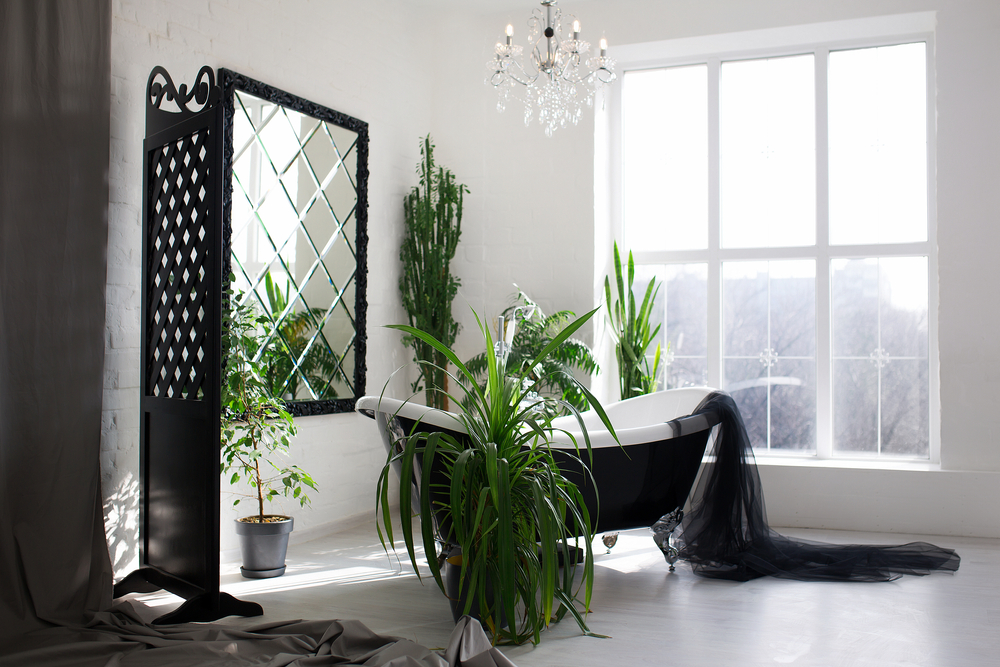
09 Aug Five Ways To Dress Your Windows For Privacy

The windows in your home are your connection with the outside world; they let light in and provide views out. How can we have privacy and still let the light in? Here are some of our favourite ways to dress your windows for privacy.
Frosted Glass
Whether you use actual frosted glass or a stick-on film, adding a translucent layer to your windows lets light in but isn’t visible through. There are different patterns available, even colours, and you can apply it to one part of the window, or all of it. Other options include textured glass and stained glass. Both involve changing the actual glass in your windows but can enhance the level of privacy. Stained glass windows in particular can look stunning in the sunshine and add real character to your property.
Shutters and Screens
Internal or external shutters and screens can make a big difference to your window privacy. External shutters and screens can either be operated electronically with a remote or by physically opening the window to access them. Internally they can be moved by hand to allow more or less visibility through the window. There is an enormous variety of shutters and screens. They can be different sizes, colours and materials but they all offer some degree of coverage. The only downside is they block light so you may be sacrificing the daylight for the privacy unlike frosted glass.
Shades and Curtains
Shades are a type of very thin and light blind that let in lots of light but attaches to the inside of the window like a blind. These are a good choice because they are not permanently fixed in place. They can be fully or half pulled down for privacy, or open to let all the light in. The downsides are that they are attached at the top of the window so you cannot use them to only cover the bottom half of a window.
If you’d like to cover just the bottom half of a window with material, then a café style curtain that is very light material such as voile is perfect. If you aren’t fussed about how much light you are letting through, then any material will do but it entirely depends on your tastes. This can be cost effective if you buy adjustable lightweight curtain poles instead of getting a proper pole drilled into your walls.
You can use lightweight curtains to let light in and keep prying eyes out. There are options to have a second curtain pole so you can have both light and heavy curtains up at the same time. Another way is to have a blackout blind, and light curtains. When the blind is open, the curtains let light in but are hard to see though.
Paper
Pasting decoupage paper onto a window is a permanent but beautiful way of adding privacy. Depending on how it is applied, and the colour or pattern, you can control more or less light getting through. In addition, you can use normal printing paper or newspaper as a short-term solution. Just use tape to affix it to the glass.
There are also some truly gorgeous types of paper available. Some that are lace-like and very thin would add privacy and pattern to a mundane pane of glass. They can also be customised to match the décor and style of the room with very little cost.
Art, Plants and Objects
Some really interesting ways of adding privacy to your windows is to hang art in the window. Hang it facing inwards, so you can enjoy beautiful artistry and as much of the window is blocked as you want it to be, depending on the size of the artwork.
Adding objects such as ornaments, colourful glass bottles, books or plants are also pretty options. Why not have hanging plants with long tendrils let light in but obscure the view? Or be bold and put shelves across the window to house rows of succulents in pots.
If you put anything opaque in front of the window you are going to sacrifice some light getting through. However, plants will thrive and allow a lot of light through still, as would glass art.
However you choose to decorate and dress your window for privacy, remember to test it properly! Ask a friend to help check just how private it is. Run a test one day and night so you know if it is as effective when it’s dark as during the day.
To do this, have someone go outside and look in the window at various distances away. You stay inside, standing in various places in the room with different lights on. This will help identify if you have missed a spot in application or need heavier curtains at night for example. On the subject of privacy, have you ever wondered how burglars use doors and windows to get access to a home?


